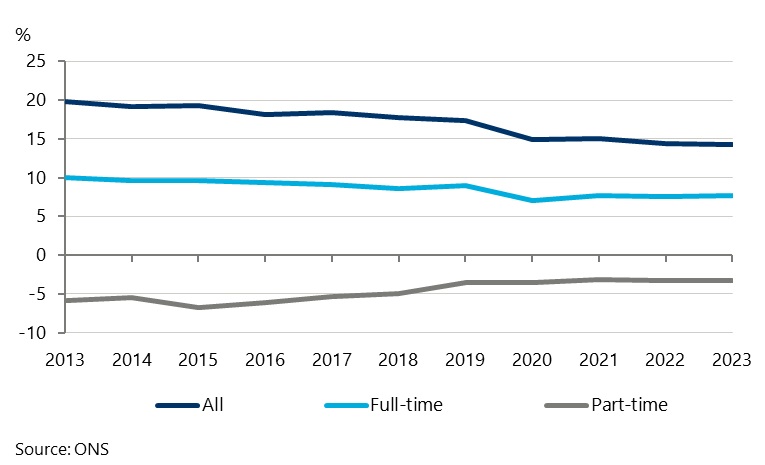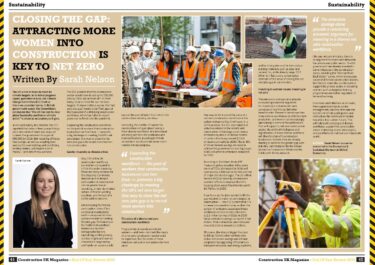Blog | 08 Mar 2024
International Women’s Day: progress of the gender pay gap in the UK

Rosie Nolan
Senior Economist, Economic Impact

The gender pay gap in the UK has gained publicity in recent years, but progress to reduce it has been slow. For full-time employees, there has been a narrowing in median gross hourly earnings between men and women by 2.3 percentage points since 2013 and at the current rate of change, the gap won’t close until 2051. With International Women’s Day being celebrated on the 8 March, examining the economic inclusion of women in the UK is of utmost priority.

Since 2017, employers with 250 or more employees in England, Scotland or Wales have been legally required to report their gender pay gap data. Reducing the gap in an organisation can benefit employers by attracting and retaining employees and enhances reputation for customers. However, research shows that customers are likely to react negatively when discovering a company’s gender pay gap.
A recent CIPD survey suggests that in the year ending October 2023, 17% of businesses mandated to produce a gender pay gap report had failed to do so, and a further 18% did not know if they had. Failing to report gender pay by these organisations is illegal, but will only result in reputational damage, in the form of a “late badge“. It could be argued that this is not an adequate deterrent.
In addition, a recent analysis demonstrates that for every £1 earned by a man in the UK, an equally-qualified woman with similar personal characteristics (including ethnicity) and professional background earns 90p on average. It is important to highlight that this is greater when ethnicity is not controlled for; women of Bangladeshi origin, for instance, face the greatest estimated pay penalty, earning on average 75% of what an equally-qualified white man would earn.
Some consider the metrics required by UK pay gap reporting (mean and median rates of hourly and bonus pay) crude measures that do not accurately describe the complexities in pay differentials between men and women. For example, women are less likely to ask for and receive pay rises than men, which slows down their pay progression. Additionally, more women tend to work part-time, where pay rates are lower. Government guidance advises that organisations could introduce policies that encourage salary negotiation, such as showing salary ranges, implementing transparent promotion and pay processes, and encouraging employees to take shared parental leave.
Research on the UK university sector suggests that pay transparency reduced the gender pay gap by 4.4%, driven by female employees negotiating higher wages. Further, analysis of OECD countries by the Centre for Progressive Policy demonstrates that the introduction of paid paternity leave entitlement of six weeks is associated with a decreased incidence of gender wage gaps by four percentage points.
Therefore, while publishing gender pay gap information may not fully explain the drivers in pay differences, it is clear the gap exists. Highlighting it will therefore increase visibility, which could encourage policies to continue to narrow the gap over time. As International Women’s Day remains a cornerstone of economic gender parity, emphasising the gap and the steps needed to minimise it must be high on all corporate boardrooms’ agendas.
Author

Rosie Nolan
Senior Economist, Economic Impact

Private: Rosie Nolan
Senior Economist, Economic Impact
London, United Kingdom
Tags:
You may be interested in

Post
Why understanding and investing in your social footprint is good for business
In the last few years issues such as the cost of living crisis, and the Covid-19 pandemic have pushed the nature of the relationship between companies and their employees, communities, and wider political context to the top of boardrooms’ agenda.
Find Out More
Post
Ride-Hailing: A Platform for Women’s Economic Opportunity in Bangladesh
In collaboration with Uber, our latest report: “Ride-Hailing: A Platform for Women’s Economic Opportunity in Bangladesh” explores the transport challenges limiting women’s economic participation in Dhaka and the role that ride-hailing can play in overcoming them.
Find Out More
Post
Closing the Gap: Attracting more women into construction is key to Net Zero.
Senior Economist Sarah Nelson expands on why women hold the key to achieving the all-important net zero target in the construction sector in Construction UK Magazine – End Of Year Review Edition 2023.
Find Out More